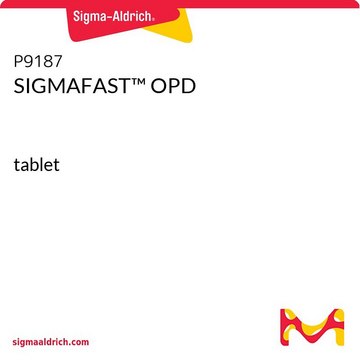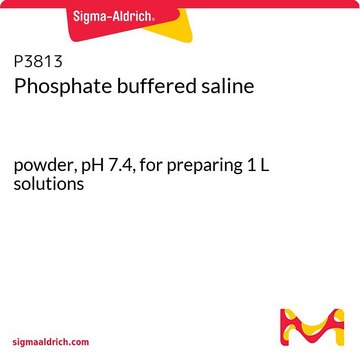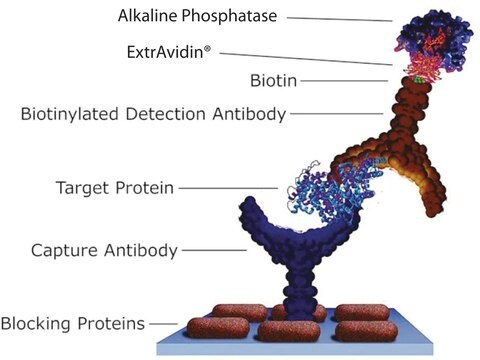AEC101
AEC Staining Kit
liquid
Synonym(s):
ACE substrate kit
Sign Into View Organizational & Contract Pricing
All Photos(2)
About This Item
UNSPSC Code:
41116134
NACRES:
NA.32
Recommended Products
form
liquid
Quality Level
usage
sufficient for ≥1,000 tests (150 ml substrate solution)
storage temp.
2-8°C
Related Categories
Application
AEC Staining Kit has been used as a substrate
- for developing the extravidin peroxidase antibody in cell-seeded matrice sections using histology and immunohistochemistry methods
- for streptavidin-horseradish peroxidase in peripheral blood mononuclear cells in ex vivo enzyme-linked immunospot (ELISPOT) assay
- for mouse IgG biotinylated secondary antibody in immunohistostaining of epididymal fat pads
Packaging
Kit contains 3 mL of concentrated acetate buffer, 3-amino-9-ethylcarbazole (AEC) chromogen and hydrogen peroxide in a dropper bottle for easy dispensing. Directions for use with each application are included.
Caution
Stable at least one year at 2-8 °C.
related product
Product No.
Description
Pricing
Signal Word
Danger
Hazard Statements
Precautionary Statements
Hazard Classifications
Acute Tox. 4 Dermal - Acute Tox. 4 Inhalation - Carc. 1B - Eye Irrit. 2 - Flam. Liq. 3 - Repr. 1B
Storage Class Code
3 - Flammable liquids
WGK
WGK 3
Flash Point(F)
134.6 °F - closed cup
Flash Point(C)
57 °C - closed cup
Certificates of Analysis (COA)
Search for Certificates of Analysis (COA) by entering the products Lot/Batch Number. Lot and Batch Numbers can be found on a product’s label following the words ‘Lot’ or ‘Batch’.
Already Own This Product?
Find documentation for the products that you have recently purchased in the Document Library.
Customers Also Viewed
Nicolas Gaudenzio et al.
The Journal of allergy and clinical immunology, 131(5), 1400-1407 (2013-03-23)
Mast cells are key components of the skin microenvironment in psoriasis, yet their functional role in this T-cell-mediated inflammatory disorder remains to be elucidated. To define the impact of T-cell/mast-cell cognate interactions on the cytokines produced by TH cells. We
Kaiyuan Ni et al.
Nature communications, 9(1), 2351-2351 (2018-06-17)
Checkpoint blockade immunotherapy enhances systemic antitumor immune response by targeting T cell inhibitory pathways; however, inadequate T cell infiltration has limited its anticancer efficacy. Radiotherapy (RT) has local immunomodulatory effects that can alter the microenvironment of irradiated tumors to synergize
Leslie R Morse et al.
Translational stroke research, 2(4), 643-650 (2012-03-01)
Spinal cord injury is associated with rapid bone loss and arrested long bone growth due to mechanisms that are poorly understood. In this study, we sought to determine the effects of severe T10 contusion spinal cord injury on the sublesional
Kuangda Lu et al.
Journal of the American Chemical Society, 138(38), 12502-12510 (2016-08-31)
Photodynamic therapy (PDT) can destroy local tumors and minimize normal tissue damage, but is ineffective at eliminating metastases. Checkpoint blockade immunotherapy has enjoyed recent success in the clinic, but only elicits limited rates of systemic antitumor response for most cancers
Identification of early secretory antigen target-6 epitopes for the immunodiagnosis of active tuberculosis
Vincenti D, et al.
Molecular Medicine, 9(3), 105-105 (2003)
Our team of scientists has experience in all areas of research including Life Science, Material Science, Chemical Synthesis, Chromatography, Analytical and many others.
Contact Technical Service












